CBSE Class 10 Science Lab Manual – Focal Length of Concave Mirror and Convex Lens
EXPERIMENT 4(a)
Aim
To determine the focal length of concave mirror by obtaining the image of a distant object.
Materials Required
A concave mirror, a mirror holder, a small screen fixed on a stand, a measuring scale and a distant object (a tree visible clearly through an open window).
Theory/Principle
The spherical mirror with inward curved reflecting surface is called concave mirror. A beam of light generally converges after reflection from its surface, hence it is also called convergent mirror (Fig. 1).

Reflection by Concave Mirror
A concave mirror obeys the laws of reflection of light. In a concave mirror, rays of light are parallel to its principal axis and meet at a single point on the principal axis, after reflection from the mirror (as shown in Fig. 2). This point is the principal focus of the mirror.
The distance between the pole and principal focus of mirror is called, focal length of the mirror.

Image of Distant Object
When a parallel beam of light coming from a distant object, such as tree or pole is incident on the reflecting surface of a mirror, then after reflection, the rays converge at its principal focus as shown in the Fig. 3.
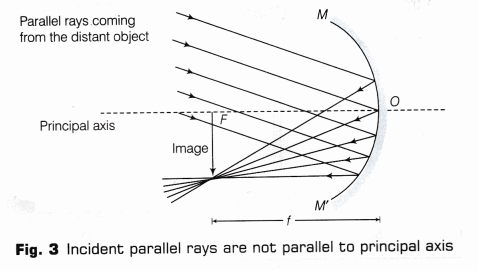
A distant object (at infinity) when reflected by a concave mirror, forms a real, diminished, and inverted image at the focus of the mirror.
As the distance between the pole 0 of the concave mirror and the focus F is the focal length of the concave mirror. Thus, the focal length of a concave mirror can be estimated by obtaining a real image of a distant object at its focus.
To obtain the position of image for a given object distance and focal length of a mirror, the following mirror formula can be used.
\(\frac { 1 }{ f } =\frac { 1 }{ v } +\frac { 1 }{ u }\)
where, u = object distance,
v = image distance and f = focal length.
All u, v and f should be according to sign convention.
This expression is valid for concave as well as convex spherical mirrors.
Procedure
- Fix a concave mirror in the mirror holder and place it on the table near an open window. Turn the face of mirror towards a distant object (suppose a tree).
- Place the screen, fitted to a stand, infront of the concave mirror. Adjust the distance of screen, so that the image of the distant object is formed on it as given in the figure below. We can infer from the figure that a clear and bright image could be obtained if the distant object (a tree), is illuminated with sunlight and the screen is placed in the shade. A bright image of the Sun could also be obtained, if the sunlight is made to fall directly on the concave mirror.
- When a sharp image of distant object is obtained, then mark the position of the centre of the stand holding the mirror and the screen as (a) and (b), respectively (see Fig. 4).
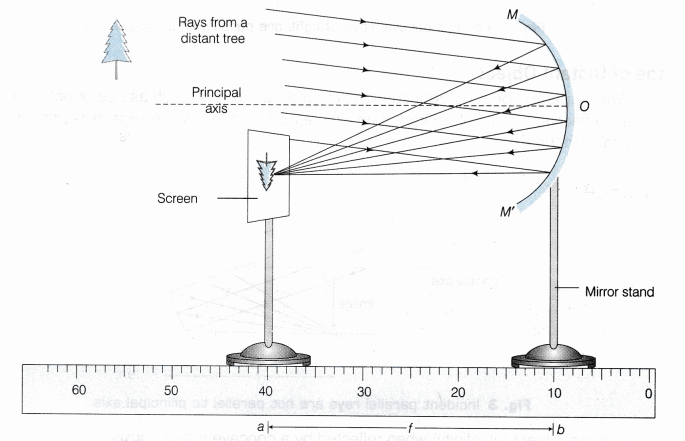

- Measure the horizontal distance between the centre of the concave mirror and the screen with the help of a measuring scale.
- Record the observations in the observation table.
- Repeat the experiment two more times by obtaining the images of two different distant objects and measure the distance between the concave mirror and the screen in each case. Record them in the observation table.
- Find the mean value of the focal length for all the observations for different objects.
Observations And Calculations
Least count of scale used = …………. mm = …………. cm
| Name of the distant object | Distance between the concave mirror and the screen (f) | Mean focal length of the concave mirror (f) in (m) | |
| in (cm) | in (m) | ||
Focal length for first object (f1) = ………… m
Focal length for second object (f2) = ………….. m
Focal length for third object (f3) = …………. m
Mean focal length = \(\frac { { f }_{ 1 }+{ f }_{ 2 }+{ f }_{ 3 } }{ 3 }\) = ………… m
Result
The approximate value of focal length of the given concave mirror is ………… m.
Precautions
- Concave mirror should be placed near an open window through which sufficient sunlight enters, with its polished surface facing the distant object.
- There should not be any obstacle in the path of rays of light incident on the concave mirror.
- If the image of the Sun has to be formed, then it should be focused on the screen only. The image of the Sun should never be seen directly with the naked eyes. Sunlight should never be focused on any part of the body as it can burn it.
- In order to obtain a sharp and clear image of the distant object on the wall/ground, it must be ensured that the object is well illuminated, so that amount of light incident on the concave mirror is sufficient to produce a well illuminated and distinct image.
- The measuring scale should be parallel to the base of both the stands.
- The mirror holder along with the mirror should be kept perpendicular to the measuring scale for precise measurements.
Sources of Error
- The measuring scale may not be parallel to the base of both the stands.
- The mirror holder, along with the mirror, may not be kept perpendicular to the measuring scale.
- Least count of measuring scale may not be correctly noted.
- Measurement of distance from pole may not be made accurate.
Viva – Voce
Question 1.
How will you distinguish between a concave and a convex mirror? [NCERT]
Answer:
A concave mirror is the spherical mirror with inward curved reflecting surface, whereas a convex mirror is the spherical mirror with outward curved reflecting surface. Concave mirror forms a sharp image, whereas a convex mirror cannot form a sharp image of the distant object.
Question 2.
To determine the focal length of a concave mirror, a student focuses a classroom window, a distant tree and the Sun on the screen with the help of a concave mirror. In which case will the student get more accurate value of focal length? [NCERT]
Answer:
Student will get more accurate value of focal length in the case of Sun.
Question 3.
What will be the nature of the image formed by a concave mirror for a distant object? [NCERT]
Answer:
The nature of the image formed by a concave mirror for a distant object is real and inverted.
Question 4.
In reflector type solar cookers, special concave (parabolic) mirrors are used. In such cookers, what should be the preferable position of food vessel for cooking? [NCERT]
Answer:
In reflector type solar cookers, the preferable position of food vessel should be at focus of the concave mirror.
Question 5.
What type of mirror is used in torch? Give reasons. [NCERT]
Answer:
In torch, concave spherical or parabolic mirror is used because when the bulb (source) is kept at the focus of a concave mirror, parallel beam of light is obtained which travels a large distance.
Question 6.
What type of mirror is used as a shaving mirror or in vanity boxes? [NCERT]
Answer:
Concave mirror is used as a shaving mirror or in vanity boxes, because when the object is placed between its focus and pole, the magnified, erect and virtual images of the object will be formed.
Question 7.
Give the condition to hold a mirror for finding the focal length of the concave mirror.
Answer:
While holding the mirror for finding the focal length of the concave mirror, the aperture of the mirror must not be obstructed.
Question 8.
Give the position of an object to obtain a virtual, erect and an image larger than the object using a concave mirror.
Answer:
The object should be placed between the focus and pole of the mirror.
Question 9.
Why do we obtain blurred image from a concave mirror sometimes?
Answer:
The reason behind the blurred image is that the mirror is away from the object.
Question 10.
How can we find the focal length of a concave mirror, when the image is obtained by using a concave mirror?
Answer:
Focal length can be found out by measuring the distance between the mirror and the screen.
Question 11.
Why do we use a screen for obtaining an image from a concave mirror?
Answer:
Since, the image formed by the mirror is real, it can be obtained on a screen.
Question 12.
Is the centre of curvature a part of a spherical mirror? Comment in support of your answer.
Answer:
The reflecting surface of a spherical mirror forms a part of a sphere. This sphere has a centre. This point is called the centre of curvature of the spherical mirror. So, it is not a part of the mirror as it lies outside its reflecting surface.
Question 13.
Which surface of a shining spoon should be polished, to use the spoon as a concave mirror?
Answer:
The surface of the spoon which is bulged outward should be polished to use the spoon as a concave mirror.
Question 14.
When the light of the Sun is directed on a sheet of paper with the help of a mirror, then the paper starts burning. Why?
Answer:
The light from the Sun is converged at a point, as the sharp, bright spot by the mirror. Actually, this spot of light is the image of the Sun on the sheet of paper. The heat produced due to concentration of sunlight ignites the paper.
Question 15.
All the rays of light, after reflection from a concave mirror meet at a point infront of the mirror. Name this point.
Answer:
When parallel rays of light fall on a concave mirror along its axis, then the rays meet at a point infront of the mirror after reflection from it. This point is called the focal point.
Question 16.
How does the size of the image vary as an object is moved from close to the pole to a large distance?
Answer:
Size of the image decreases as the object is moved away from the pole to a large distance. The image will be virtual for the object between the pole and the focus.
Question 17.
State the importance of pole of a mirror.
Answer:
Pole is the mid-point of the mirror which makes the incident light to go at some angle on the other side of principal axis.
EXPERIMENT 4(b)
Aim
To determine the focal length of convex lens by obtaining the image of a distant object.
Apparatus/Materials Required
A thin convex lens, a lens holder, a small screen fixed on a stand and a measuring scale.
Theory/Principle
A lens which is thicker at the centre and thinner at its ends is called convex lens.
Convex lenses are of three types (as shown in Fig. 1):
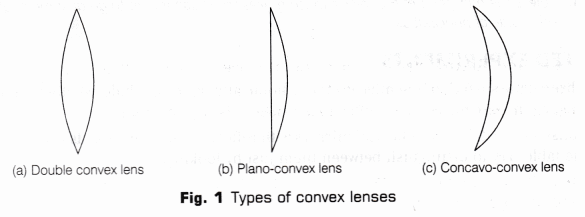
Note: A convex lens is also known as converging lens because it converges a parallel beam of light rays passing through it. A double convex lens is simply called convex lens.
The distance between the optical centre O of the convex lens and the focus F1 or F2 is its focal length (see Fig. 2).

Reflection by Convex Lens
When the parallel beam of light coming from a distant object (such as the sun, a building, a tree, etc.) falls on a convex lens, the rays after refraction, converge at a point on its other side. This point is one of the two foci of the lens.
Formation of Image
If the parallel beam of light comes from a distant object, then a real, inverted image of very small size is formed at the focus of the lens as given in the Fig. 3.
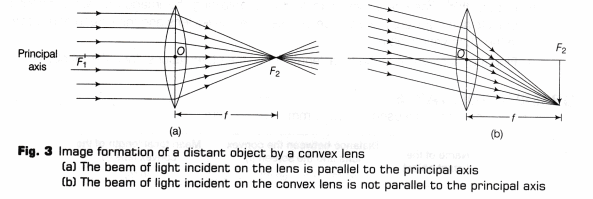
Since, the image formed by the lens is real so it can also be obtained on a screen as that of concave mirror. As, the focal length of a convex lens is equal to the distance between optical centre and any of its focus. So, focal length can be estimated by obtaining a real image of a distant object at its focus.
To obtain the position of image for a given object distance and focal length of a lens, the following lens formula can be used.
\(\frac { 1 }{ f } =\frac { 1 }{ v } -\frac { 1 }{ u }\)
where, u = object distance, v = image distance and f = focal length.
All u, v and f should be according to sign convention.
This expression is valid for both types of lenses, i.e. convex and concave.
Procedure
- Fix a thin convex lens on the lens holder and place it on the table same as that done in the case of concave mirror.
- Place the screen fixed to a stand on the other side of the lens. Adjust the position of screen by moving it back and forth in front of the convex lens to get a sharp and clear image of the distant object.
- Mark the position of the centre of the stands holding the lens and the screen, when a sharp image of the distant object (tree) has been obtained on the screen as shown in Fig. 4.
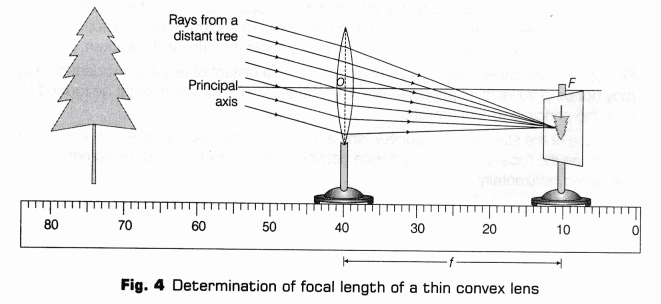
- Now, measure the horizontal distance between the centre of the convex lens and the screen with the help of a measuring scale.
- Record the observations in the observation table.
- Repeat this experiment two more times by obtaining the images of two different distant objects and measure the distance between the convex lens and the screen and record them in the observation table.
- Find the mean value of the focal length for all the observations, for different objects.
Observation Table
Least count of scale used = ………… mm = ………… cm
| Name of the distant object | Distance between the convex lens and the screen (f) | Mean focal length of the convex lens (f) in (m) | |
| in (cm) | in (m) | ||
Calculations
Focal length for first object (f1) = ………… m
Focal length for second object (f2) = ………… m
Focal length for third object (f3) = ……………. m
Mean focal length or approximate focal length of lens (f) = \(\frac { { f }_{ 1 }+{ f }_{ 2 }+{ f }_{ 3 } }{ 3 }\)
Result
From the above observations and calculations, the approximate value of focal length of the given convex lens is ………. m.
Precautions
- The principal axis of the convex lens should be horizontal, i.e. the lens should be placed vertically.
- There should be no obstacle in the path of rays of light from the distant object incident on the convex lens.
- The image of the sun formed by the lens should be focussed only on the screen. The image of the sun should never be seen directly with the naked eye or it should never be focussed with a convex lens on any part of the body, paper or any inflammable material as it can burn.
- Sometimes, the parallel rays of light originating from a distant object and incident on a convex lens may not be parallel to its principal axis. The image in such situation might be formed slightly away from the principal axis of the lens.
- The base of the stands of the convex lens and screen should be parallel to measuring scale. To determine the focal length, the distance between the convex lens and the screen should be measured horizontally.
Sources of Error
- The principal axis of convex lens may not be in horizontal position.
- There may be some obstacle in the path of light ray, coming from the distant object.
Viva – Voce
Question 1.
How will you distinguish between a convex and concave lens? [NCERT]
Answer:
| Convex lens | Concave lens |
| Its focal length is positive. | Its focal length is negative. |
| It converges light rays towards principal axis. | It diverges light rays away from principal axis. |
| Image formed may be real or virtual. | Always forms virtual image. |
Question 2.
To determine the focal length of a convex lens, a student focusses a classroom window, a distant tree and the Sun on the screen. In which case, will the student is closer to accurate value of focal length? [NCERT]
Answer:
In the case of Sun, because it works as an infinite object and rays will be perfectly parallel to the principal axis.
Question 3.
What is the nature of an image formed by a thin convex lens for a distant object? What change do you expect, if the lens were rather thick? [NCERT]
Answer:
The nature of an image is real, inverted and diminished. If lens becomes thicker, only focal length of lens decreases.
Question 4.
You are provided with two convex lenses of same aperture and different thickness. Which one of them will be of shorter focal length? [NCERT]
Answer:
A thick convex lens has shorter focal length.
Question 5.
|f we cover one-half of the convex lens, while focussing a distant object, in what way will it affect the image formed? [NCERT]
Answer:
If we cover one-half of the convex lens, there will be no change in the nature of lens, only intensity of the image formed decreases.
Question 6.
Can this method be used to find the approximate focal length of the concave lens? [NCERT]
Answer:
No, this method cannot be used to find the approximate focal length of the concave lens, because it always forms a virtual image.
Question 7.
Which type of lens is used by the watchmakers, while repairing five parts of a wrist watch? [NCERT]
Answer:
Watchmakers use convex lens, and to obtain enlarged image, they place the object between optical centre and focal length.
Question 8.
Give the complete detail of the nature of image so formed in this experiment.
Answer:
The nature of image formed in this experiment is as follows:
- Real
- Inverted
- Diminished
- At focus
Question 9.
When a ray of light emerges out from a denser medium of the lens, how will it bend into the rarer medium of air?
Answer:
It bends away from the normal at the point of incidence on the interface.
Question 10.
How will a ray of light falling on a denser medium of convex lens bend?
Answer:
It bends towards the normal at the point of incidence on a denser medium of lens.
Question 11.
What happens to a ray of light when it passes through the optical centre of a lens?
Answer:
When a ray of light passes through the optical centre of a lens, it goes without bending.
Question 12.
State whether the nature of image formed by a convex lens depends on the position of object.
Answer:
Yes, it forms virtual image only when placed between focus and optical centre and for all other positions, it forms real image.
Question 13.
On what factor, does the ability of a lens to converge or diverge the light rays depend?
Answer:
It depends upon the focal length of the lens.
Question 14.
If the lens used in the experiment is a plano-convex lens, then what is the radius of curvature of the plane surface?
Answer:
The radius of curvature of the plane surface of plano-convex lens is infinity.
Science Lab ManualScience Practical SkillsScience LabsMath LabsMath Labs with Activity